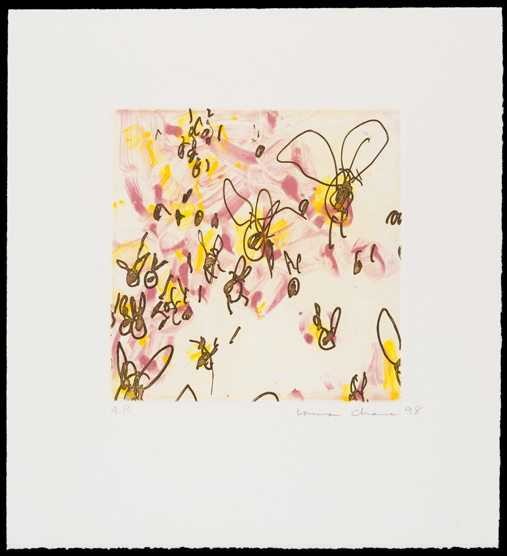At first glance, you might consider the images created by Louisa Chase playful, sometimes even exuberant—simplified pictographs dancing in a composition of color, environmental forms and figurative representations suspended in layers of gestural mark-making. Upon closer inspection, the imagery reveals the introspective self-examination of an artist trying to reveal the ephemeral through a physical process—what she described as “a constant search to hold a feeling tangible.”
Louisa Lizbeth Chase (American, born Panama, 1951–2016) was raised in Lancaster, Pennsylvania. A graduate of Syracuse University (BFA, Printmaking, 1973) and the prestigious graduate program at Yale University (MFA, 1975), Chase explored a variety of media, from experimental drawing to inflatable sculpture. She flourished in New York City early in her career and was one of few female artists to gain renown during the resurgence of painting in the 1980s, a movement generally associated with the artists of New Image painting and Neo Expressionism. In 1984, Chase’s work was included in the landmark exhibition Paradise Lost/Paradise Regained: American Visions of the New Decade, organized by the New Museum of Contemporary Art to represent the United States at the Venice Biennale. That same year, the Institute of Contemporary Art in Boston presented the nationally-traveling solo exhibition New Currents: Louisa Chase. In 1991, Chase left Manhattan for Sag Harbor before settling in East Hampton, where she lived and worked until her death in 2016.
Louisa Chase: Below the Surface is the first survey of the artist’s work since her death, representing nearly forty years of art-making. Early paintings illustrate the foundation of Chase’s visual vocabulary, seen in the simplified imagery and mark-making consistent throughout her career. The feeling of innocence imbuing her work from the 70s and early 80s gradually evolves into the aggressive excavation of her canvases. The resulting impasto offers a picture plane that has no perspective but is in no way flat. This sense of duality is central to Chase’s work: the balance between order and chaos, the dichotomy of image and intent, the unified expression of the divided self. She comes full circle within her most recent work, returning to the impish color palette and demeanor of her early painting but incorporating the assertive and introspective mark refined over a lifetime—what she defined as “kamikaze curiosity.” Louisa Chase routinely returned to the medium of printmaking throughout her career, publishing well over 60 editioned prints and countless variations, proofs, and monoprints. The selected prints on view mirror the stylistic evolution evident in her paintings and drawings, transitioning from the simplified forms of her early woodcuts, to the complex strata in her combined etching and relief impressions, and finally, to the sophisticated and self-reflexive compositions seen in her lithographs and monoprints.








